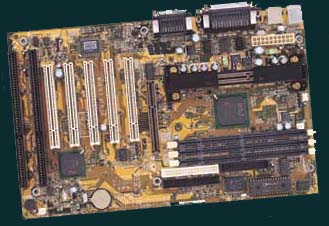Hardware
Audio
Controllers
General
Mainboards
Memory
Modems
Monitors
Portables
Printers
Processors
Scanners
Storage
Video
Games
Reviews
Previews
Cheats
& Hints
News
General Info
About
Us
Advertising
Awards
Contact
Us
Hot
Links
|
MSI MS-6163 Manufacturer
Micro
Star International
Expansion
Slot : 5/2/1
Hereís
another board that has the potential to become the choice of overclockers
everywhere, even though you canít compare Micro Star International, given
their history, with the likes of Abit and ASUS. Anyway, the MS-6163 stands
apart from the competition because of its four voltage presets. Thatís
right, the MS-6163 allows you to choose between four preset voltage settings
of 2.0V, 2.05V, 2.1V and 2.2V. OK, so it may not allow you to manually
fine tune the voltage as the Abit boards do but something is better than
nothing, isnít it? (Yes, it is, donít argue) Most especially if you have
a Celeron 300A or a Pentium II 300 (SL2W8). Overclocking to 504MHz requires
a slight voltage increment in some cases where you have to pump up 2.2V.
Unfortunately, the MS-6163 doesnít include a 1.8V preset for those of you
who run your processors at this voltage. Always something to spoil an overclockerís
day. But as I said before, something is better than nothing, half a loaf
is better than none, and donít look a gift horse in the mouth.
The
board is a 5 PCI/ 2 ISA/1 AGP configuration; the only thing missing is
the fourth DIMM socket, but that can be excused in a board like this one.
The board is a jumperless model and features a utility called Plug and
Play II to tweak the board, similar to Abitís Soft Menu II.
Unlike ASUS, MSI has decided to give a thermistor free of charge along
with the board. With this, the MS-6163 provides all the hardware
monitoring features seen on boards such as the ASUS P2B-F and the Abit
BX6 rev 2.0.
|
|
|
|
|

